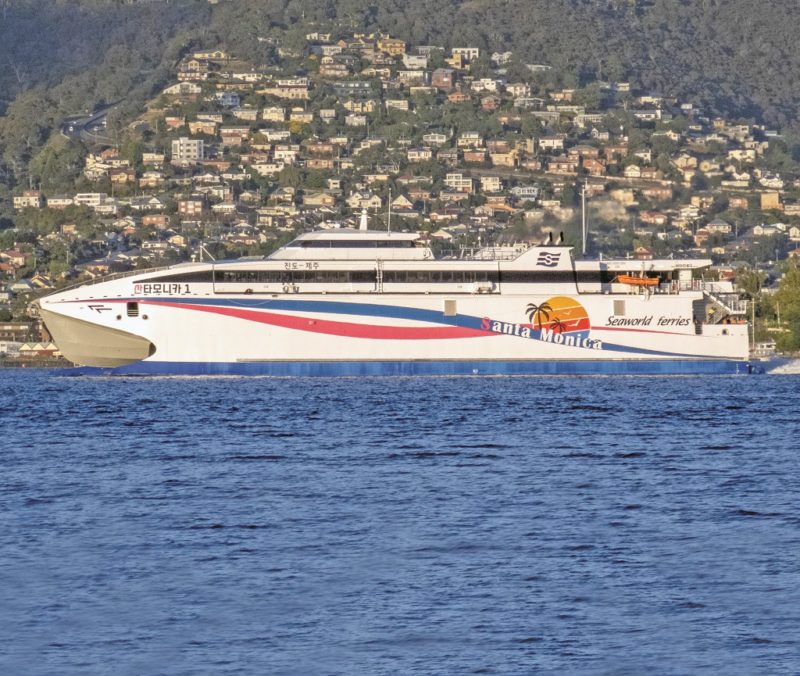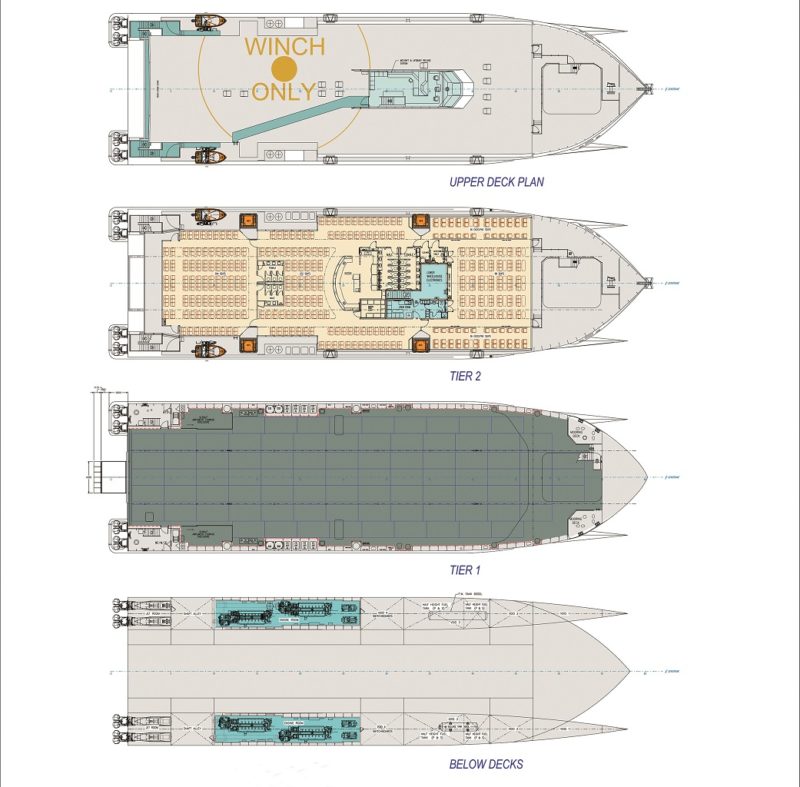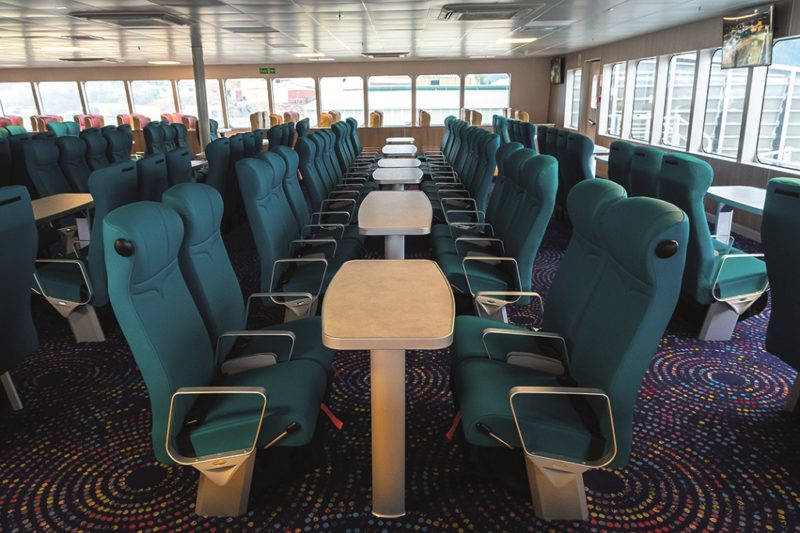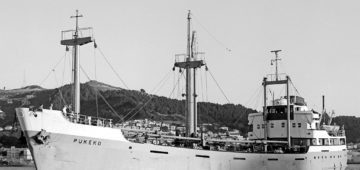Large fast vehicle ferries have seen a renaissance in recent years as major ferry operators renew or expand their fleets. On the whole, the robust, twin-hulled designs have shone through with Austal and Incat taking the Lion’s share of orders. The unmistakable profile of the Seacat wave piercing vehicle and passenger carrying catamarans is carried through into the 21st century examples. The legacy of the Seacat family is scattered around the world, with the highest concentration still being in the northern hemisphere. All owe their existence to the rather humble beginnings of International Catamarans Pty Ltd. (Incat) in 1983. Incat conceived the Wave Piercing fast ferry design after much research and development. Hull 013 became the 8.70m prototype, named Little Devil, with trials taking place in 1984. The results encouraged Incat to proceed with a 28m Wave Piercing Catamaran, the Spirit of Victoria (Hull 016), which entered commercial operation in 1985. The Tassie Devil 2001 (Hull 017) was launched in December 1986 and Incat’s first foray into the UK market involved two passenger catamarans built for Sealink British Ferries’ Portsmouth-Ryde cross-Solent ferry service in 1986 (The Our Lady Patricia and Our Lady Pamela which survived until 2006/09 respectively). The current range of Wave Piercing Catamarans mirror the characteristics of various early craft. The mainstream design of vehicle carrying wave piercer burst onto the scene in 1990 when the 74m Seacat, the Hoverspeed Great Britain (HGB-Hull 025), was launched on 28th January 1990. On her delivery voyage from Australia to Britain the Hoverspeed Great Britain surpassed the Hales Trophy/Blue Riband transatlantic crossing record by 3 hours 14 minutes. Since then, the 91m Buquebus owned Catalonia (Hull 047 and now Golden Fast Ferries’ Super Express, 5,902gt/built 1998) captured this honour with a crossing of three days, 9 hours and 40 minutes whilst the current holder is another Incat vessel, the 5,619gt/1998 built and 91m Skane Jet (ex-Fjord Cat of Fjord Line).
The HGB’s service debut was not the smoothest but these ground-breaking craft quickly carved a niche for themselves and became commonplace at various ports around Europe and further afield. The craft grew in size and in 2007 the “Evolution One12” 112m design arrived, the largest so far, with the first example being delivered to Japanese operator Higashi Nihon Ferry. By 2008 Incat had built almost 40% of the world’s high-speed vehicle-passenger ferry fleet over 50 metres in length. In deadweight terms Incat has built over 60% of the world’s high-speed ferries with capacity that exceeds 750 tonnes. While the ferries initially revolutionised transport links around the United Kingdom and Europe, Incat-built ships now operate elsewhere, including North and South America, Australasia and Asia. Incat’s latest newbuild, and the subject of this feature, is a nod towards the original size of Seacat but with a refined/redesigned profile more akin to the 100m long Incat 94, the 6,726gt/2021-built Buccoo Reef. Seaworld Express Ferry Co. Ltd. of the Republic of Korea ordered a 76m long vehicle and passenger craft with the keel laying ceremony taking place at Incat’s Hobart Shipyard on 29th September 2020.
Seaworld Express Ferry Co. Ltd. began passenger operations in December 1998 with a conventional Ro-Pax ferry joining the company in 2003. Besides this newbuild fast ferry, the 2022 fleet consists of the 552gt passenger catamaran Queenstar 2 for the 75-mile route Chuja-Jeju (444 passengers & 39m long), the 27,391gt/2020-built, 170m long and 1,284 passenger capacity Ro-Pax ferry Queen Jenuvia (serving the 92-mile Mokpo-Jeju route) and the 13,665gt/1998-built, 192m long and 1,264 passenger capacity Ro-Pax ferry Queen May (serving the 92-mile Mokpo-Jeju route). Seaworld Express Ferry also owned the 23,900gt/1996-built Ro-Pax Santa Lucino for 15 years and scrapped her in 2021 at Chattogram, Bangladesh, as the Lucino 1 after failing to attract a buyer. The ship was replaced in the fleet by the Queen Jenuvia. The company is one of several that serves the Islands of South Korea and operates to Jeju Island, the country’s largest and most populated island, which covers an area of 707.8 square miles. Jeju Island lies in the Korea Strait, below the Korean Peninsula, south of the South Jeolla Province and is located 51.4 miles off the nearest point on the peninsular. Some services from Jeju also serve the Chuja Islands, a group of 42 islands in the Jeju Strait, about halfway between Jeju and the southern coast of Jeollanamdo. Only four islands are inhabited. Nearer to the mainland, Jindo Island is 140.22 square miles and the third largest island in South Korea. Together with a group of much smaller islands, it forms Jindo County and is located in South Jeolla province, just off the southwest corner of the Korean peninsula. It is linked to the mainland via a road bridge but also has a ferry port.
Inter-Island Incat
The newbuild was ordered in March 2020 for a Jindo-Chuja-Jeju service, a route subsidised by the Southern Korean authorities. The company website shows this route to be a distance of 55 miles with up to two sailings per day. Seaworld Express Ferry was selected as operator for the route in recognition of its past track record, current financial health and superior business plan. The 75.70m long Seacat has a 20.60m beam, a draught of 2.35m and is a bespoke model to suit the requirements of the Buyer. Just as Incat led the way with the world’s first car-carrying highspeed catamarans in the pioneering 74m and 78m fast ferries of the early 1990s, this new vessel is a market frontrunner in terms of economy, seakeeping and comfort for vessels of its size. Capable of accommodating 621 passengers and crew and 86 cars at speeds of over 40 knots, Incat 097 features Incat’s tried and proven evolved hull-form with its new centre-bow arrangement, reflecting over 30 years of experience building fast vehicle-passenger ferries. With a significant improvement to both waterline length and vessel trim compared with those early vessels, together with a Motion Control System, the 76 metre catamaran benefits not only from vastly improved speed and fuel consumption but also provides a smoother ride and an enhanced onboard experience for both passengers and crew. The name bestowed upon the newbuild is Santa Monica 1 and she was designed by Revolution Design. Following her launch on 4th January 2022, sea trials achieved a maximum speed of 49.7 knots compared to the contractual speed of 42 knots with 100 tonnes deadweight aboard.
The vessel lay out is traditional with machinery spaces in the hulls, vehicle deck, passenger areas and navigation bridge on 4 levels. Passengers can enjoy an abundance of natural light in the public spaces that feature high quality carpet, durable timber-look walkways, stainless steel fittings and tasteful wall panelling. All passenger facilities are situated on one deck fitted out for 606 passengers with 72 executive seats and 98 reclining seats in the forward business class lounge, 232 seats midships and 204 seats in the aft cabin, all supplied by Beurteaux.

A services block separates the forward and midship sections and houses male and female toilets, a crew mess and a centrally located servery, food preparation area and bar. Finished with stainless steel and glass cabinets to display hot and cold meals, drinks and desserts, the servery is bounded by wide corridors either side allowing customers easy viewing and access while preventing crowding and long queues.
As with all large Incat vessels the superstructure, Tier 2 and above, is an independent structure, connected to the hull via rubber isolation mounts, for optimum noise and vibration performance.
The vehicle deck covers an area of 1,030m3 and the deckload is 5 tonnes (single axle dual wheel) between the transom and frame 47 for HGVs and 2 tonnes (single axle) elsewhere. The clear height of the commercial vehicle lanes is 3.5m and the HGV lanes are 3.10m wide compared to 2.3m for the car lanes.
The freight capacity is 256 lanemetres with car capacity being for 86 vehicles based on each being 4.5m long and 2.3m wide. There is also an additional 37.6m2 of stowage space for motorbikes and freight.
Vehicles are handled via a vessel-mounted ramp at the stern, measuring 4.7m long and 4.46m wide, with a maximum deckload of 5 tonnes. The use of extensive lighting and apertures at the foredeck and stern provide a high level of natural light and air movement through the vehicle deck and is enhanced by the light tones of rapid access composite Structural Fire Protection provided by Ayres. All vertical structural steel members are painted bright yellow so obstructions to vehicles or passenger movement are easily identified. Situated atop the passenger deck, the Santa Monica 1’s wheelhouse features the latest navigation, monitoring, and control equipment.
A dedicated docking station, 360-degree views and CCTV deliver a high level of safety and control during voyages and docking. The vessel offers views from raised helm seating, with all instruments fitted in dark grey and black consoles to aid night vision and to minimise distraction. A separate ship’s office and lounge is located aft of the bridge where crew can lay-out charts, plan voyages or relax from day-to-day activities.
The craft is equipped with four Caterpillar C280-16 engines which each deliver 5,650kW at 100% MCR. Each engine drives a steerable Kongsberg Kamewa S90-4 waterjet via a Reintjes VLJ 4431 gearbox. Four Caterpillar C7.1 generators rated at 200ekW each and 380V, 60Hz, supply electrical power. Ride control whilst the vessel is at sea features two active interceptors and a motion control system. It will be interesting to see if a further Incat of this size joins the Santa Monica 1 on the services to Jeju. That said, on 17th January 2022 Incat announced another order for a 76m vessel for Daezer Construction of South Korea, for delivery in 2023. The vessel will operate for Daezer on the service between Pohang and Ulleung, an island 117 nautical miles off the eastern coast of South Korea where the main economic activity is tourism.
Incat is no stranger to South Korean waters having delivered its first vessel to the region in 1995, the 78m long K50 catamaran Sunflower (Incat 037). The Sunflower served Ulleung island for 25 years and was only retired by Daezer in compliance with South Korean ship age limits. By coincidence, the completion of this feature coincided with the 32nd Anniversary of the Hoverspeed Great Britain’s arrival in Falmouth on 23rd June 1990 having won the Hales Trophy.








Comments
Sorry, comments are closed for this item